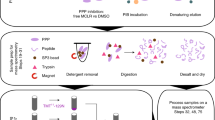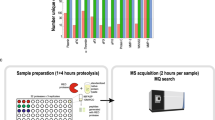Abstract
Matrix metalloproteinases (MMPs) are zinc endopeptidases composed of 23 members in humans, which belong to a subfamily of the metzincin superfamily. They play important roles in many pathophysiological events including development, organogenesis, angiogenesis, tissue remodeling and destruction, and cancer cell proliferation and progression by degradation of extracellular matrix (ECM) and non-ECM proteins and interaction with various molecules. Here, we present standard protocols for purification of native proMMPs (proMMP-1, -2, -3, -7, -9 and -10) and recombinant MT1-MMP (MMP-14) using conventional column chromatography. Purification steps comprise the initial common step [diethylaminoethyl (DEAE)-cellulose, Green A Dyematrex gel and gelatin–Sepharose columns], the second step for removal of nontarget proMMPs by immunoaffinity columns (anti-MMP-1 and/or anti-MMP-3 IgG–Sepharose columns) and the final step for further purification (IgG–Sepharose, DEAE-cellulose, Zn2+-chelate-Sepharose and/or gel filtration columns). Purified proMMPs and MMP are functionally active and suitable for biochemical analyses. The basic protocol for the purification from culture media takes ∼7–10 d.
This is a preview of subscription content, access via your institution
Access options
Subscribe to this journal
Receive 12 print issues and online access
$259.00 per year
only $21.58 per issue
Buy this article
- Purchase on Springer Link
- Instant access to full article PDF
Prices may be subject to local taxes which are calculated during checkout





Similar content being viewed by others
References
Egeblad, M. & Werb, Z. New functions for the matrix metalloproteinases in cancer progression. Nat. Rev. Cancer 2, 161–174 (2002).
Seiki, M. The cell surface: the stage for matrix metalloproteinase regulation of migration. Curr. Opin. Cell Biol. 14, 624–632 (2002).
Visse, R. & Nagase, H. Matrix metalloproteinases and tissue inhibitors of metalloproteinases: structure, function, and biochemistry. Circ. Res. 92, 827–839 (2003).
Handsley, M.M. & Edwards, D.R. Metalloproteinases and their inhibitors in tumor angiogenesis. Int. J. Cancer 115, 849–860 (2005).
Okada, Y. Proteinases and matrix degradation. In Kelley's Textbook of Rheumatology 7th edition (eds. Harris, E.D. Jr., Budd, R.C., Genovese, M.C., Firestein, G.S. & Sargent J.S.) 63–81 (W.B. Saunders Company, Philadelphia, 2005).
Gross, J. & Lapiere, C.M. Collagenolytic activity in amphibian tissues: a tissue culture assay. Proc. Natl. Acad. Sci. USA 48, 1014–1022 (1962).
Baker, A.H., Edwards, D.R. & Murphy, G. Metalloproteinase inhibitors: biological actions and therapeutic opportunities. J. Cell Sci. 115, 3719–3727 (2002).
Pilcher, B.K. et al. The activity of collagenase-1 is required for keratinocyte migration on a type I collagen matrix. J. Cell Biol. 137, 1445–1457 (1997).
Krekoski, C.A., Neubauer, D., Graham, J.B. & Muir, D. Metalloproteinase-dependent predegeneration in vitro enhances axonal regeneration within acellular peripheral nerve grafts. J. Neurosci. 22, 10408–10415 (2002).
Fukai, F. et al. Release of biological activities from quiescent fibronectin by a conformational change and limited proteolysis by matrix metalloproteinases. Biochemistry 34, 11453–11459 (1995).
Holliday, L.S. et al. Initiation of osteoclast bone resorption by interstitial collagenase. J. Biol. Chem. 272, 22053–22058 (1997).
Lochter, A. et al. Matrix metalloproteinase stromelysin-1 triggers a cascade of molecular alterations that leads to stable epithelial-to-mesenchymal conversion and a premalignant phenotype in mammary epithelial cells. J. Cell Biol. 139, 1861–1872 (1997).
Hiraoka, N., Allen, E., Apel, I.J., Gyetko, M.R. & Weiss, S.J. Matrix metalloproteinases regulate neovascularization by acting as pericellular fibrinolysins. Cell 95, 365–377 (1998).
Chun, T.H. et al. A pericellular collagenase directs the 3-dimensional development of white adipose tissue. Cell 125, 577–591 (2006).
Fowlkes, J.L., Enghild, J.J., Suzuki, K. & Nagase, H. Matrix metalloproteinases degrade insulin-like growth factor-binding protein-3 in dermal fibroblast cultures. J. Biol. Chem. 269, 25742–25746 (1994).
Thrailkill, K.M. et al. Characterization of insulin-like growth factor-binding protein 5-degrading proteases produced throughout murine osteoblast differentiation. Endocrinology 136, 3527–3533 (1995).
Whitelock, J.M., Murdoch, A.D., Iozzo, R.V. & Underwood, P.A. The degradation of human endothelial cell-derived perlecan and release of bound basic fibroblast growth factor by stromelysin, collagenase, plasmin, and heparanases. J. Biol. Chem. 271, 10079–10086 (1996).
Imai, K., Hiramatsu, A., Fukushima, D., Pierschbacher, M.D. & Okada, Y. Degradation of decorin by matrix metalloproteinases: identification of the cleavage sites, kinetic analyses and transforming growth factor-beta1 release. Biochem. J. 322, 809–814 (1997).
Manes, S. et al. Identification of insulin-like growth factor-binding protein-1 as a potential physiological substrate for human stromelysin-3. J. Biol. Chem. 272, 25706–25712 (1997).
Hashimoto, G. et al. Matrix metalloproteinases cleave connective tissue growth factor and reactivate angiogenic activity of vascular endothelial growth factor 165. J. Biol. Chem. 277, 36288–36295 (2002).
Shiomi, T. et al. Pericellular activation of proMMP-7 (promatrilysin-1) through interaction with CD151. Lab. Invest. 85, 1489–1506 (2005).
Overall, C.M. & Kleifeld, O. Tumour microenvironment—opinion: validating matrix metalloproteinases as drug targets and anti-targets for cancer therapy. Nat. Rev. Cancer 6, 227–239 (2006).
Ito, A. et al. Degradation of interleukin 1beta by matrix metalloproteinases. J. Biol. Chem. 271, 14657–14660 (1996).
Powell, W.C., Fingleton, B., Wilson, C.L., Boothby, M. & Matrisian, L.M. The metalloproteinase matrilysin proteolytically generates active soluble Fas ligand and potentiates epithelial cell apoptosis. Curr. Biol. 9, 1441–1447 (1999).
McQuibban, G.A. et al. Inflammation dampened by gelatinase A cleavage of monocyte chemoattractant protein-3. Science 289, 1202–1206 (2000).
Noë, V. et al. Release of an invasion promoter E-cadherin fragment by matrilysin and stromelysin-1. J. Cell Sci. 114, 111–118 (2001).
Kajita, M. et al. Membrane-type 1 matrix metalloproteinase cleaves CD44 and promotes cell migration. J. Cell Biol. 153, 893–904 (2001).
Sheu, B.C. et al. A novel role of metalloproteinase in cancer-mediated immunosuppression. Cancer Res. 61, 237–242 (2001).
Fiore, E., Fusco, C., Romero, P. & Stamenkovic, I. Matrix metalloproteinase 9 (MMP-9/gelatinase B) proteolytically cleaves ICAM-1 and participates in tumor cell resistance to natural killer cell-mediated cytotoxicity. Oncogene 21, 5213–5223 (2002).
Lynch, C.C. et al. Matrix metalloproteinase 7 mediates mammary epithelial cell tumorigenesis through the ErbB4 receptor. Cancer Res 67, 6760–6767 (2007).
Sawey, E.T., Johnson, J.A. & Crawford, H.C. Matrix metalloproteinase 7 controls pancreatic acinar cell transdifferentiation by activating the Notch signaling pathway. Proc. Natl. Acad. Sci. USA 104, 19327–19332 (2007).
Yu, W.H., Woessner, J.F. Jr., McNeish, J.D. & Stamenkovic, I. CD44 anchors the assembly of matrilysin/MMP-7 with heparin-binding epidermal growth factor precursor and ErbB4 and regulates female reproductive organ remodeling. Genes Dev. 16, 307–323 (2002).
Labrecque, L. et al. Src-mediated tyrosine phosphorylation of caveolin-1 induces its association with membrane type 1 matrix metalloproteinase. J. Biol. Chem. 279, 52132–52140 (2004).
Nisato, R.E. et al. Dissecting the role of matrix metalloproteinases (MMP) and integrin alpha(v)beta3 in angiogenesis in vitro: absence of hemopexin C domain bioactivity, but membrane-Type 1-MMP and alpha(v)beta3 are critical. Cancer Res. 65, 9377–9387 (2005).
Fujita, Y. et al. Tetraspanin CD151 is expressed in osteoarthritic cartilage and is involved in pericellular activation of pro-matrix metalloproteinase 7 in osteoarthritic chondrocytes. Arthritis Rheum 54, 3233–3243 (2006).
Okada, Y., Nagase, H. & Harris, E.D. Jr. A metalloproteinase from human rheumatoid synovial fibroblasts that digests connective tissue matrix components. Purification and characterization. J. Biol. Chem. 261, 14245–14255 (1986).
Okada, Y., Harris, E.D. Jr. & Nagase, H. The precursor of a metalloendopeptidase from human rheumatoid synovial fibroblasts. Purification and mechanisms of activation by endopeptidases and 4-aminophenylmercuric acetate. Biochem. J. 254, 731–741 (1988).
Okada, Y. et al. Matrix metalloproteinase 2 from human rheumatoid synovial fibroblasts. Purification and activation of the precursor and enzymic properties. Eur. J. Biochem. 194, 721–730 (1990).
Okada, Y. et al. Matrix metalloproteinase 9 (92-kDa gelatinase/type IV collagenase) from HT 1080 human fibrosarcoma cells. Purification and activation of the precursor and enzymic properties. J. Biol. Chem. 267, 21712–21719 (1992).
Imai, K. et al. Membrane-type matrix metalloproteinase 1 is a gelatinolytic enzyme and is secreted in a complex with tissue inhibitor of metalloproteinases 2. Cancer Res. 56, 2707–2710 (1996).
Ohuchi, E. et al. Membrane type 1 matrix metalloproteinase digests interstitial collagens and other extracellular matrix macromolecules. J. Biol. Chem. 272, 2446–2451 (1997).
Nakamura, H., Fujii, Y., Ohuchi, E., Yamamoto, E. & Okada, Y. Activation of the precursor of human stromelysin 2 and its interactions with other matrix metalloproteinases. Eur. J. Biochem. 253, 67–75 (1998).
Shimada, T. et al. Characterization of a truncated recombinant form of human membrane type 3 matrix metalloproteinase. Eur. J. Biochem. 262, 907–914 (1999).
Imai, K. et al. Matrix metalloproteinase 7 (matrilysin) from human rectal carcinoma cells. Activation of the precursor, interaction with other matrix metalloproteinases and enzymic properties. J. Biol. Chem. 270, 6691–6697 (1995).
Watanabe, H., Nakanishi, I., Yamashita, K., Hayakawa, T. & Okada, Y. Matrix metalloproteinase-9 (92 kDa gelatinase/type IV collagenase) from U937 monoblastoid cells: correlation with cellular invasion. J. Cell Sci. 104, 991–999 (1993).
Itoh, M. et al. Purification and refolding of recombinant human proMMP-7 (pro-matrilysin) expressed in Escherichia coli and its characterization. J. Biochem. 119, 667–673 (1996).
Kinoshita, T. et al. TIMP-2 promotes activation of progelatinase A by membrane-type 1 matrix metalloproteinase immobilized on agarose beads. J. Biol. Chem. 273, 16098–16103 (1998).
Conlon, J.M. Purification of naturally occurring peptides by reversed-phase HPLC. Nat. Protoc. 2, 191–197 (2007).
Shechter, D., Dormann, H.L., Allis, C.D. & Hake, S.B. Extraction, purification and analysis of histones. Nat. Protoc. 2, 1445–1457 (2007).
Shapiro, S.D. et al. Activation of the 92-kDa gelatinase by stromelysin and 4-aminophenylmercuric acetate. Differential processing and stabilization of the carboxyl-terminal domain by tissue inhibitor of metalloproteinases (TIMP). J. Biol. Chem. 270, 6351–6356 (1995).
Shipley, J.M. et al. The structural basis for the elastolytic activity of the 92-kDa and 72-kDa gelatinases. Role of the fibronectin type II-like repeats. J. Biol. Chem. 271, 4335–4341 (1996).
Stricklin, G.P., Bauer, E.A., Jeffrey, J.J. & Eisen, A.Z. Human skin collagenase: isolation of precursor and active forms from both fibroblast and organ cultures. Biochemistry 16, 1607–1615 (1977).
Harayama, T. et al. Shedding of membrane type 1 matrix metalloproteinase in a human breast carcinoma cell line. Jpn. J. Cancer Res. 90, 942–950 (1999).
Templeton, N.S. et al. Cloning and characterization of human tumor cell interstitial collagenase. Cancer Res. 50, 5431–5437 (1990).
Muir, D. & Manthorpe, M. Stromelysin generates a fibronectin fragment that inhibits Schwann cell proliferation. J. Cell Biol. 116, 177–185 (1992).
Chevallet, M., Luche, S. & Rabilloud, T. Silver staining of proteins in polyacrylamide gels. Nat. Protoc. 1, 1852–1858 (2006).
Moutsiakis, D., Mancuso, P., Krutzsch, H., Stetler-Stevenson, W. & Zucker, S. Characterization of metalloproteinases and tissue inhibitors of metalloproteinases in human plasma. Connect. Tissue Res. 28, 213–230 (1992).
Birkedal-Hansen, H. Catabolism and turnover of collagens: collagenases. Methods Enzymol. 144, 140–171 (1987).
Nagase, H. Human stromelysins 1 and 2. Methods Enzymol. 248, 449–470 (1995).
Nakamura, H. et al. Brevican is degraded by matrix metalloproteinases and aggrecanase-1 (ADAMTS4) at different sites. J. Biol. Chem. 275, 38885–38890 (2000).
Ward, R.V., Hembry, R.M., Reynolds, J.J. & Murphy, G. The purification of tissue inhibitor of metalloproteinases-2 from its 72 kDa progelatinase complex. Demonstration of the biochemical similarities of tissue inhibitor of metalloproteinases-2 and tissue inhibitor of metalloproteinases-1. Biochem. J. 278, 179–187 (1991).
Rozanov, D.V. & Strongin, A.Y. Membrane type-1 matrix metalloproteinase functions as a proprotein self-convertase. Expression of the latent zymogen in Pichia pastoris, autolytic activation, and the peptide sequence of the cleavage forms. J. Biol. Chem. 278, 8257–8260 (2003).
Acknowledgements
We are grateful to all the previous and current members of Y.O.'s lab who contributed to the development of these techniques. Y.O. was supported by the grant-in-aid from the Ministry of Education, Science and Culture of Japan (19109004).
Author information
Authors and Affiliations
Corresponding author
Rights and permissions
About this article
Cite this article
Imai, K., Okada, Y. Purification of matrix metalloproteinases by column chromatography. Nat Protoc 3, 1111–1124 (2008). https://doi.org/10.1038/nprot.2008.74
Published:
Issue Date:
DOI: https://doi.org/10.1038/nprot.2008.74
This article is cited by
-
Transformed MDCK cells secrete elevated MMP1 that generates LAMA5 fragments promoting endothelial cell angiogenesis
Scientific Reports (2016)
-
Highly efficient and easy protease-mediated protein purification
Applied Microbiology and Biotechnology (2016)
-
MMP-Inhibitor-Screening mittels Zelloberflächen-modifizierter Hefen
BIOspektrum (2013)
Comments
By submitting a comment you agree to abide by our Terms and Community Guidelines. If you find something abusive or that does not comply with our terms or guidelines please flag it as inappropriate.



